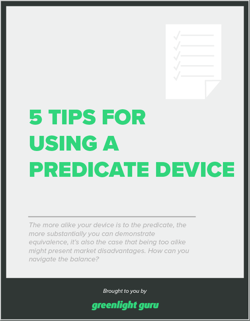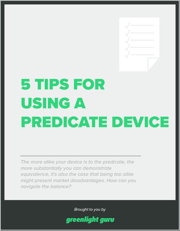How to Demonstrate Substantial Equivalence in 5 Easy Steps

If you’re taking the 510(k) route to market for your medical device, demonstrating substantial equivalence is essential.
This might sound simple in theory, but it’s clear that a number of companies don’t really understand what this means. Out of all rejected submissions, a large amount of those submissions are due to failure to demonstrate substantial equivalence to a predicate device.
So first things first, let's look at what “substantial equivalence” actually means then explain what you need to do to demonstrate it:
FREE RESOURCE: Click here to download a PDF with 5 valuable tips for using a predicate device.
Substantial equivalence overview
When you submit a 510(k), the FDA is concerned with the two most important aspects: your risk mitigation strategy and your demonstration of substantial equivalence.
As far as substantial equivalence goes, the traditional 510(k) program operates on the rule that there must be equivalence with a predicate device.
A predicate device is a medical device that may be legally marketed in the U.S. and used as a point of comparison for new medical devices seeking approval through FDA’s 510(k) premarket clearance pathway. The new device must be proven to be substantially equivalent in safety and efficacy to the predicate device in order to receive clearance.
How close to the predicate device must the new device be? The regulation doesn’t say. That part is up to the manufacturer to negotiate, working with the FDA. Demonstrating substantial equivalence means you have to emphasize the similarities and de-emphasize the differences.
Is an apple substantially equivalent to an orange? Well, once again, you want to underscore the similarities: They are both fruits, they both grow on trees, they both deliver calories and nutrients, they both have skin, they both have seeds, etc. But you also want to minimize the differences: they are different colors, they have different nutritional content, they grow on different trees, and so on.
FDA provides guidance on substantial equivalence in which they recommend that medical device manufacturers choose a predicate device that is most similar to your device with regard to indications for use and technological characteristics.
Demonstrate substantial equivalence in 5 steps
Let's explore the five essential steps to demonstrating substantial equivalence, beginning with the first step.
1. Determine if your product’s intended use is substantially equivalent to a predicate device
Your first step to demonstrating substantial equivalence is to determine if your product’s intended use is substantially equivalent to a predicate device.
How do you do this? The FDA’s guidance says: “Section 513(i)(1)(E) of the Act generally limits the determination of the intended use of a device that is the subject of a premarket notification (510(k)) to the proposed labeling contained in the submission.”
Labeling includes labels that are affixed to the device, on its packaging, any inserts within the packaging and in advertising or promotional materials such as your website. The FDA will evaluate all labeling to determine the intended use of the medical device and additionally, whether it is substantially equivalent to a predicate device.
Also of note is that FDA may accept a substantial equivalence claim upon the determination that there is a “reasonable likelihood” the device will be used for the same intended use as the predicate device without being listed on the labeling.
2. Identify similarities and differences between your product and predicate device to be included in comparison table
A core task of your 510(k) submission is to compare the technological characteristics of your medical device with the predicate device. The bottom line is that in order to be eligible for the 510(k) pathway, you must convince the FDA of the “sameness” of your device with the predicate.
What if there are differences? There almost always are and it’s your job to convince FDA that those differences are not so great that they should deem your device to be technologically different.
You will need to do a deep comparison that uncovers the essential nature of the technology. There is plenty of room for your own logic and creativity to come into play - if you compare apples and oranges, they’re both fruits with high nutritional value for consumers!
Where technology is different, it may still be allowed on the 510(k) pathway if the differences won’t raise questions of safety or effectiveness. Check out FDA’s recommended procedure for conducting a benefit-risk analysis for additional guidance.
3. Determine if the product code components of the predicate device are substantially equivalent to your product code
The FDA has a database that contains all medical devices approved under 510(k). The classification of your device and the product code are essential in searching for a predicate device. You can even find 510(k) summary documents that will provide some tips on how to show substantial equivalence.
More information about the classification database from FDA is described below:
To find the classification of your device, as well as whether any exemptions that may exist, you need to find the regulation number that is the classification regulation for your device. There are two methods for accomplishing this: go directly to the classification database and search for a part of the device name, or, if you know the device panel (medical specialty) to which your device belongs, go directly to the listing for that panel and identify your device and the corresponding regulation.
You can learn more about how to determine the classification of your device by reading our Guide to Medical Device Classification.
4. Provide performance data that supports substantial equivalence determination
New guidance issued by the FDA in early 2019 allowed a shift in substantial equivalence from the testing of predicate devices to well-established performance testing criteria and methodologies. In essence, they are saying that certain “well understood” medical devices may be cleared based on performance criteria rather than comparison testing to a predicate device.
This is known as the Safety and Performance Based Pathway and according to the FDA, it can be used when:
-
The new device has indications for use and technological characteristics that do not raise different questions of safety and effectiveness than the identified predicate.
-
The performance criteria align with the performance of one or more legally marketed devices of the same type as the new device.
-
The new device meets all the performance criteria
The performance criteria are defined in FDA guidance documents and FDA-recognized consensus standards, as well as special controls (e.g., special labeling requirements).
5. Produce 510(k) summary proving 510(k) submission supports a substantial equivalence determination from FDA
The 510(k) summary comprises the final section of your 510(k) submission. The FDA has clarified that your summary must be in sufficient detail so that it provides an understanding of the basis for a determination of substantial equivalence.
The goal is that this section should be the summary of the rest of your submission. You should provide a summary or the “cliff notes” of your substantial equivalence comparison.
One thing to note here is that the FDA publishes the 510(k) summary section of your submission to the public within 30 days of their decision. This means you will want to walk a fine line between including everything that the FDA expects in a summary, while not including too many details that you wouldn’t otherwise want public, namely for competitive or intellectual property reasons.
FREE RESOURCE: Click here to download a PDF with 5 valuable tips for using a predicate device.
Proving substantial equivalence is easy with the right QMS solution
What helps you overall in making your case for substantial equivalence? Having well-organized documentation and a robust QMS.
The best QMS software is cloud-based, allowing you and your team quick access to the most up-to-date information. You should be able to quickly navigate to the documentation that will prove your device is substantially equivalent.
Greenlight Guru is purpose-built for medical device companies with a dedicated document management software module that makes it especially easy for you to find the information you need, when you need it. Get your free demo of our QMS software now.
Looking for a design control solution to help you bring safer medical devices to market faster with less risk? Click here to take a quick tour of Greenlight Guru's Medical Device QMS software
Tom Rish is a Medical Device Guru at Greenlight Guru who works with customers to utilize their QMS software to build safer products on expedited timelines. He is a Biomedical Engineer who began his career developing implant and instrument systems in the orthopedic industry. He enjoys helping customers successfully...
Related Posts
Understanding the Premarket Approval (PMA) Process
7 FDA Pathways to Bring Your Medical Device to Market
Submitting a 510(k)? First Make Sure You Know What 'Substantial Equivalence' Means
Get your free resource
5 Tips for Using a Predicate Device











